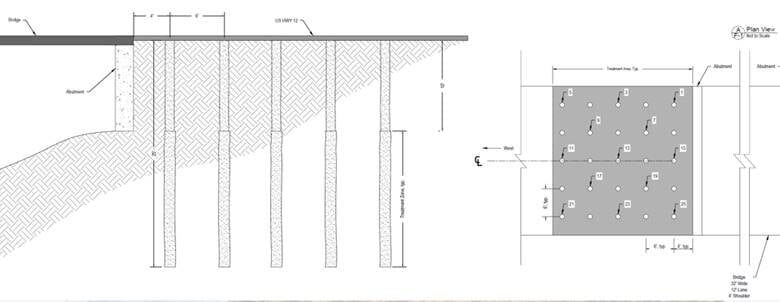

Whether dealing with bridge replacement and bridge repairs or creating an entirely new structure, bridge abutments are one of the most critical elements of a bridge’s durability. But engineers can only work with the geography they have, and sometimes they must fill in the area between their bridge spans with denser materials.
A recently completed project for a western state’s Department of Transportation required the compaction of a soft fill zone from 10 to 25 feet below roadway grade on either side of the bridge abutment. The project required one lane to be opened to alternating traffic at all times during the work.
After comparing the grouting program’s pre-and post-SPT borings, GeoStabilization International®, produced a significant 50% or more blow-count improvement in the treated zones.
Bridge abutments require a deep foundation and need to be much more rigid than their nearby embankments. If the abutment’s construction is deficient, the bridge substructure will settle and weaken over time. This, in turn, damages the bridge spans and bridge deck, requiring lengthy and costly replacement operations. GeoStabilization utilizes a variety of methods to densify and fill bridge abutments. These methods include:
Compaction grouting reduces the impact of ground settlement on all types of bridges. In the case of sinkholes or other sudden damage to the ground, compaction grouting has saved many bridges from total ruin. This type of grouting also increases the load-carrying capacity of the soil at the bridge’s foundation. In turn, this reduces future settlements and increases the bridge’s level of safety. Slurry, permeation, and chemical grouting reduce water seepage and enhance the underpinning of bridge foundations.
Foundation underpinning, meanwhile, focuses on enhancing existing structures. In most cases, this entails extending the bridge foundation’s depth or breadth with concrete. This allows it to rest on a more supportive foundation, extending the life of the bridge.
Finally, approach releveling and void filling deal with the area around the bridge foundation. Releveling is the process of adjusting the bridge’s approach so it is flush with its span. Void filling fills in any gaps near a bridge’s foundations where water can build up.
If a bridge is not near the end of its service life, it is nearly always more cost-effective and less disruptive to rehabilitate it instead of replacing it outright. Bridge abutment rehabilitation costs up to 70% less than replacement, and the process allows construction workers to make repairs while the bridge remains open to traffic. In addition, there are fewer permitting requirements for bridge substructure repair, which allows us to perform these repairs as needed at regular intervals.
GeoStabilization International® is one of the top providers of bridge approach and total bridge rehab in the United States and Canada. Combining advanced technology with top-tier service to extend the service life of bridge abutments up to 75 years. Contact us today to learn how our team can help mitigate whatever geohazards your project faces.
If you are interested in a no-obligation site visit to determine if our services fit your geohazard mitigation needs, call us at 855-579-0536 or fill out our contact form.